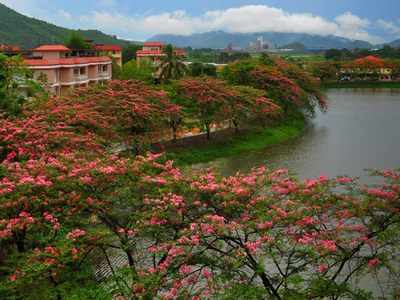- News
- Education News
- News
- IIT Guwahati develops membranes that can separate oil and water
Trending
This story is from August 20, 2019
IIT Guwahati develops membranes that can separate oil and water
Indian Institute of Technology, Guwahati (IITG) researchers have developed two distinct and special membranes that can separate oil and water, even under harsh conditions, to manage oil spill catastrophes.

Representational Image
GUWAHATI: Indian Institute of Technology, Guwahati (IITG) researchers have developed two distinct and special membranes that can separate oil and water, even under harsh conditions, to manage oil spill catastrophes.
The newly developed membranes that are super-water repellent in air, and super oil-repellent in water, have been shown to separate complex mixtures of oil and water at practically relevant settings which has proved to be a landmark achievement as oil-water separation is vital in environmental applications like oil spill management.
The research work undertaken by Uttam Manna, assistant professor of the Chemistry department at IITG along with his research team comprising Avijit Das, Dibyangana Parbat and Arpita Shome has been able to develop a prototype of oil-water separation device using these membranes such that the separated oil and water were simultaneously collected in different containers. Considering the significance of their work, it has recently been endorsed in the ACS Sustainable Chemistry & Engineering journal.
"Oil-water separation is of current relevance because many industries, such as mining, textiles, food and petrochemicals, produce massive volumes of oily wastewater, which must be treated before discharge," said Uttam Manna, underlining the need to develop materials that can separate oil and water.
While these bio-inspired membranes have been individually used to separate oil and water in the recent past, there was accumulation of water or oil on the membrane over time, which blocked further separation.
Manna said that there was yet another problem with conventional demonstration, where the superhydrophobic and superoleophobic materials are individually exploited for demonstration of oil/water separation-mostly using two phase oil and water mixtures. He said that those approaches were inappropriate for separation of three-phase mixtures of heavy oil, light oil and water, as one of the liquid phase of oil/water mixture is accumulated on top of the either superhydrophobic or underwater superoleohopbic membrane for conventional set-up.
In addition, for practical use, these materials were required to operate under harsh conditions and had to be subjected to severe stretching and bending during operation, and most of the earlier reported materials are inappropriate to sustain such practically relevant severe settings.
In order to overcome these problems, Manna and his team developed a system of 'super liquid repellent' materials, by combining the lotus leaf superhydrophobicity and fish scale superoleophobicity.
The durable and stretchable membranes that the team developed were super-water-repellent in air and super-oil-repellent in water. "These separation systems allow continuous, parallel and selective separation of various oil and water mixtures, irrespective of surface tension, density, and viscosity of the oil phase and chemical complexity in the water phase", Manna said while explaining the design of the device.
Not stopping with preliminary testing of these membranes, the research team expanded testing to study the performance of the membranes from three phase oil and water mixtures under severe conditions such as extremes of pH, artificial seawater and river water. They found that the separation performance was excellent even after exposure to extreme conditions.
Some important and relevant applications for such special surfaces are anti-biofouling coatings, oil-water separation for both industrial purposes and for treating oil spills and other such environmental catastrophes.
The newly developed membranes that are super-water repellent in air, and super oil-repellent in water, have been shown to separate complex mixtures of oil and water at practically relevant settings which has proved to be a landmark achievement as oil-water separation is vital in environmental applications like oil spill management.
The research work undertaken by Uttam Manna, assistant professor of the Chemistry department at IITG along with his research team comprising Avijit Das, Dibyangana Parbat and Arpita Shome has been able to develop a prototype of oil-water separation device using these membranes such that the separated oil and water were simultaneously collected in different containers. Considering the significance of their work, it has recently been endorsed in the ACS Sustainable Chemistry & Engineering journal.
"Oil-water separation is of current relevance because many industries, such as mining, textiles, food and petrochemicals, produce massive volumes of oily wastewater, which must be treated before discharge," said Uttam Manna, underlining the need to develop materials that can separate oil and water.
Scientists have studied the surface structures of lotus leaves and fish scales to understand what gives them their superhydrophobicity (super-water repellence) and superoleophobicity (super-oil repellence), respectively, so that these structures can be replicated artificially for oil-water separation applications. Thus, lotus leaf-inspired superhydrophobic materials and fish scale-inspired superoleophobic materials have been developed, following a single and unique deposition process and tested for gravity-driven removal of oil from water.
While these bio-inspired membranes have been individually used to separate oil and water in the recent past, there was accumulation of water or oil on the membrane over time, which blocked further separation.
Manna said that there was yet another problem with conventional demonstration, where the superhydrophobic and superoleophobic materials are individually exploited for demonstration of oil/water separation-mostly using two phase oil and water mixtures. He said that those approaches were inappropriate for separation of three-phase mixtures of heavy oil, light oil and water, as one of the liquid phase of oil/water mixture is accumulated on top of the either superhydrophobic or underwater superoleohopbic membrane for conventional set-up.
In addition, for practical use, these materials were required to operate under harsh conditions and had to be subjected to severe stretching and bending during operation, and most of the earlier reported materials are inappropriate to sustain such practically relevant severe settings.
In order to overcome these problems, Manna and his team developed a system of 'super liquid repellent' materials, by combining the lotus leaf superhydrophobicity and fish scale superoleophobicity.
The durable and stretchable membranes that the team developed were super-water-repellent in air and super-oil-repellent in water. "These separation systems allow continuous, parallel and selective separation of various oil and water mixtures, irrespective of surface tension, density, and viscosity of the oil phase and chemical complexity in the water phase", Manna said while explaining the design of the device.
Not stopping with preliminary testing of these membranes, the research team expanded testing to study the performance of the membranes from three phase oil and water mixtures under severe conditions such as extremes of pH, artificial seawater and river water. They found that the separation performance was excellent even after exposure to extreme conditions.
Some important and relevant applications for such special surfaces are anti-biofouling coatings, oil-water separation for both industrial purposes and for treating oil spills and other such environmental catastrophes.
End of Article
FOLLOW US ON SOCIAL MEDIA











